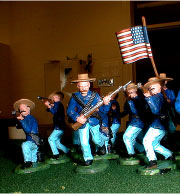 Teddy's
Wild Ride
Teddy's
Wild RideFast Play Rules for San Juan Hill
 Teddy's
Wild Ride
Teddy's
Wild RideVersion 2: I made some changes to these rules. The original version can be found here. The main change was to the turn sequence, which has more phases, but which I think simplifies things. The US soldiers now move only 6" rather than having the choice of moving 12" or shooting.
Historical Background: In 1898 the US battleship Maine exploded while docked in Cuba. Blame immediately fell on Spain, which was trying to put down a revolt on the island. A short time later, the Spanish American War had begun. After the war was over the US had become a world power and acquired her first colonies: Guam, Puerto Rico, Cuba, and the Philippines. The most famous land battle in this short conflict occurred at San Juan Hill. Teddy Roosevelt and his Rough Riders were among those that gained fame by storming the Spanish trenches on the hills surrounding the city of Santiago. The African American cavalry troopers known as the "Buffalo Soldiers" also fought bravely in this battle.
After Action Reports: This game was played with two different groups of middle school students.
Battle 1: The Spanish commander on Kettle Hill asked for
permission to abandon the position before the battle began. His
fellow commanders refused the request. This may account for the
lackluster performance put on by the Spanish defenders on the
hill. The Rough Riders and Buffalo Soldiers overran the position
without difficulty and continued their assault towards the heights
of San Juan Hill. Elsewhere, the US Army was taking a terrible
beating as they struggled up the slopes of San Juan Hill.
The Buffalo soldiers and Rough Riders stormed the Spanish trenches
on the left side of San Juan Hill in a flash. As the Americans
raced towards the summit a desperate Spanish officer signaled
the artillerymen to fire a barrage on the Spanish trenches. The
timing was perfect. The shells caught the Buffalo soldiers while
they were celebrating their victory, and regrouping for an assault
on the block house. More troopers were lost in that instant than
had been lost in the fights for the trenches on Kettle and San
Juan Hills combined. On the other side of the block house the
US army managed to penetrate the Spanish defenses with a savage
thrust. Unfortunately this attacking force was quickly cut off
and surrounded. They clung tenaciously to a small section of the
Spanish trenches, rallying around Color Sergeant Bailey. In a
dramatic and heroic conflict that became known as "Bailey's
Last Stand" the Americans fought to the bitter end. Sgt.
Bailey himself protected the US flag until he ran out of ammunition.
He continued to fight, using the flag staff as a weapon, until
he was finally overwhelmed by superior numbers. Sgt. Bailey was
recommended for the Medal of Honor. His actions were not in vain,
as his men effectively tied up a large portion of the Spanish
reserves, preventing them from helping in the defense of the block
house. When the Rough Riders and Buffalo soldiers successfully
stormed the block house effective Spanish resistance was ended.
It was a victory for the Americans.
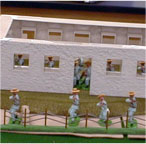 Battle
2: The Spanish fought fiercely as the Americans advanced.
A continuous barrage of accurate artillery fire rained on the
attackers. The Rough Riders suffered badly as they fought through
the defenses on Kettle Hill. Suddenly the Spanish on the hill
seemed to panic and retreat. The Americans rushed to capture the
abandoned trenches. Without warning the fleeing Spanish turned
and counterattack. This unexpected maneuver caught the Rough Riders
completely by surprise, and unprepared. The Spanish hit the disorganized
Americans with a fury. Colonel Teddy Roosevelt was among the casualties.
The Americans solemnly paused to consider how American History
would be changed without the dynamic leadership of President Teddy
Battle
2: The Spanish fought fiercely as the Americans advanced.
A continuous barrage of accurate artillery fire rained on the
attackers. The Rough Riders suffered badly as they fought through
the defenses on Kettle Hill. Suddenly the Spanish on the hill
seemed to panic and retreat. The Americans rushed to capture the
abandoned trenches. Without warning the fleeing Spanish turned
and counterattack. This unexpected maneuver caught the Rough Riders
completely by surprise, and unprepared. The Spanish hit the disorganized
Americans with a fury. Colonel Teddy Roosevelt was among the casualties.
The Americans solemnly paused to consider how American History
would be changed without the dynamic leadership of President Teddy
Roosevelt. The Rough Riders vowed revenge and quickly swept the
hill clear of the enemy, with some timely help from the Buffalo
Soldiers. Unfortunately for them their battle was only half over.
they still had to climb the slope of San Juan Hill where the remaining
Spaniards were waiting.
On the American left the US Army
had been making slow but steady progress up San Juan Hill. Spanish
rifles and artillery shells inflicted many casualties, but could
not stop the American advance. The arrival of the Gatling Guns
provided the necessary firepower to get the Americans to the barbed
wire. With a "hurrah" the Americans fired a deadly volley
into the
Spanish trenches before charging with the bayonet. The army overwhelmed
the Spanish defenders and began rolling up the flank. Several
attempts were made to capture the block house but they were repulsed.
On the right flank the weary survivors of the Kettle Hill battle also attempted to close with the enemy. Only a few Buffalo Soldiers, led by Jack Pershing, made it to the Spanish lines. The Spanish counterattacked, cutting off Pershing's men. Pershing and his Buffalo Soldiers fought like demons, but were eventually defeated. The victorious Spanish rushed reinforcements towards the besieged block house. A desperate struggle for control of the house ensued. The Americans were close to the breaking point when they finally put an end to the Spanish resistance and captured the position. Surveying the carnage the Americans conceded that the Rough Riders and Buffalo Soldiers had been shattered, Roosevelt and Pershing were dead, and that the Army was in no shape to continue the drive on Santiago. This was a Pyrrhic victory for the Americans.
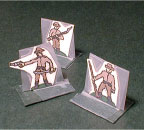 The
Soldiers: You could use
Airfix or Imex 1/72 scale Confederate infantry for both sides
in this battle. I used 54 mm figures from BMC. These are ugly
figures. I chose figures from their San Juan Hill set (which includes
a house, fortifications and Gatling guns) and also used some from their Alamo
set. Some Spanish soldiers were painted as US soldiers to fill out their ranks.
Spanish officers were marked by painting their cuffs and shoulder straps red. US
officers were painted with a yellow stripe on their trouser, and yellow shoulder
straps or stripes. Here are some
paper soldiers you can print and use.
The
Soldiers: You could use
Airfix or Imex 1/72 scale Confederate infantry for both sides
in this battle. I used 54 mm figures from BMC. These are ugly
figures. I chose figures from their San Juan Hill set (which includes
a house, fortifications and Gatling guns) and also used some from their Alamo
set. Some Spanish soldiers were painted as US soldiers to fill out their ranks.
Spanish officers were marked by painting their cuffs and shoulder straps red. US
officers were painted with a yellow stripe on their trouser, and yellow shoulder
straps or stripes. Here are some
paper soldiers you can print and use.
The Orders of Battle: The Spanish have 46 figures (including 1 officer). The US Army has 78 figures (including 2 flag bearers), there are 23 Buffalo Soldiers (including 2 flag bearers, an officer, and Jack Pershing), and 27 Rough Riders (including Teddy Roosevelt and a flag bearer). There are 4 machine guns (two operators for each) deployed with the Rough Riders. Two Gatling guns (2 operators for each) arrive on turn 3.
Set Up: The Spanish must be in the trench lines on San Juan Hill or Kettle Hill. Six Figures can fit in the blockhouse. The Americans start at the opposite end of the board, within 6" of the edge.
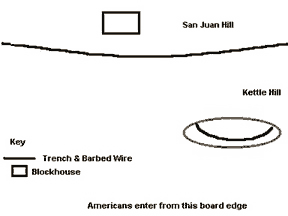 The
Map: This game represents
the final push to take the hills. It's difficult to model San
Juan Hill since the whole board is really a slope upward. An easy
way to represent this is to use felt or a model to show the summits
of each hill. The rest of the board should be clear. Since the
terrain is a slope figures do not block line of sight, so you
can fire over the heads of the figures in front.
The
Map: This game represents
the final push to take the hills. It's difficult to model San
Juan Hill since the whole board is really a slope upward. An easy
way to represent this is to use felt or a model to show the summits
of each hill. The rest of the board should be clear. Since the
terrain is a slope figures do not block line of sight, so you
can fire over the heads of the figures in front.
Objective: The Americans must clear the Spanish off Kettle and San Juan Hills.
Turn Sequence:
Spanish Artillery
Spanish Shoot
Spanish Move
Spanish Unpin
Melee
US Shoot
US Move
US Unpin
Melee
Artillery: Each turn the Spanish players may toss four cotton or paper balls onto the table to represent artillery fire. Because we used 54mm figures we found that cotton balls were too small. We suggest crumbling a piece of paper into a ball and using it for artillery. The tosser should be standing at least one foot behind his table edge when he tosses each ball. After the ball is tossed and rolls to a stop any figures touching it, or within 1/2" are eliminated as casualties. It doesn't matter if the ball knocks over a figure, it only matters where the ball ends up after the toss. If the artillery hits a Spanish figure the figure is still eliminated.
Movement: Figures may move 6".
Barbed Wire: American figures must stop at the barbed wire. The following turn they don't move, but they may remove the wire in front of them. No figures may move past the wire on the turn it is being removed. On the following turn any figures may move through the gap in wire.
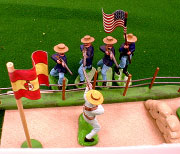 Shooting:
Everything is always in range. Spanish roll 1D6 per figure.
A roll of 5 pins one figure, a 6 eliminates a figure. Americans
need a 6 to hit, and half the hits (round up) will be pins, the
rest will be kills. Americans may not fire at the Spanish until
they reach the barbed wire. Spanish figures in the block house
are invulnerable to US fire, they must be defeated in melee. The
player losing figures gets to choose which figures are eliminated
or pinned. The figures chosen should be in the front lines, but
an officer doesn't have to be eliminated if another figure is
neaby.
Shooting:
Everything is always in range. Spanish roll 1D6 per figure.
A roll of 5 pins one figure, a 6 eliminates a figure. Americans
need a 6 to hit, and half the hits (round up) will be pins, the
rest will be kills. Americans may not fire at the Spanish until
they reach the barbed wire. Spanish figures in the block house
are invulnerable to US fire, they must be defeated in melee. The
player losing figures gets to choose which figures are eliminated
or pinned. The figures chosen should be in the front lines, but
an officer doesn't have to be eliminated if another figure is
neaby.
Pins: Figures that are pinned should be tipped over, or turned face up. They may not move or shoot until they are unpinned. Pinned figures cannot initiate a melee, but they can defend themselves if attacked.
Machine Guns: Roll 3D6 when they fire. They hit on a 6, but if two of the dice are the same then the weapon is out of ammo for the remainder of the game.
Gatling Guns: They work like machine guns but they roll 6D6 and don't run out of ammo.
Melee: If a figure moves into contact with an enemy figure
they will fight hand-to-hand. Each combatant rolls 1D6 and adds
any modifiers. The highest modified roll wins and the loser is
eliminated. The Spanish win ties. If more than one figure is able
to reach an enemy figure then the fights are treated as a series
of one on one fights. 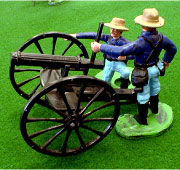 A figure that
wins melee may not continue to attack other neaby figures.
A figure that
wins melee may not continue to attack other neaby figures.
| Officers, flag bearers | +1 |
| Defending the blockhouse | +1 |
| Opponent is pinned | +1 |
Useful Resources:
"Assault on San Juan Hill"
by Richard E. Killblane, http://www.thehistorynet.com/
"Solo Spanish-American War" by Scott Hansen, Lone
Warrior #124
The Spanish American War Centennial Website, http://www.spanamwar.com/